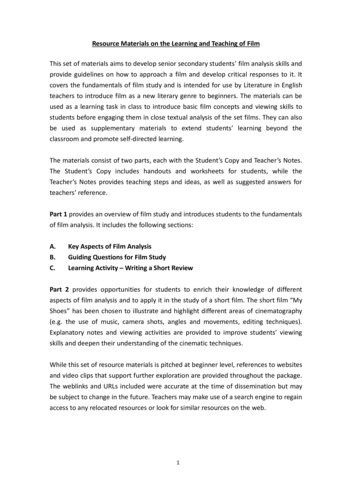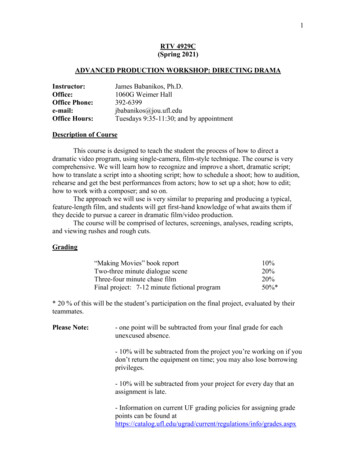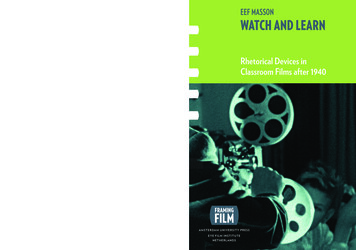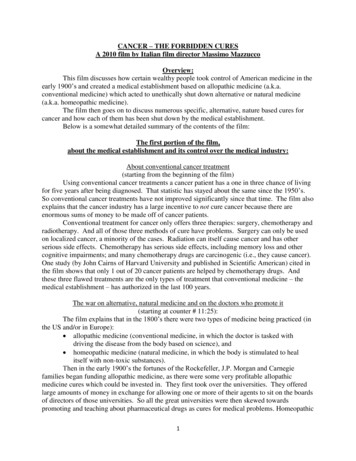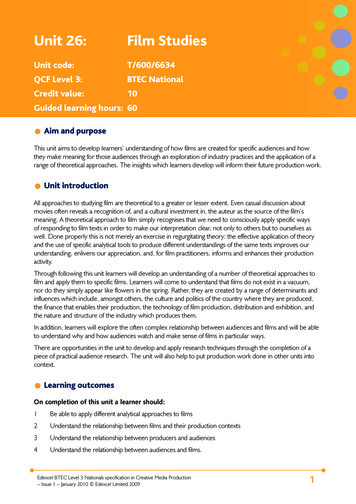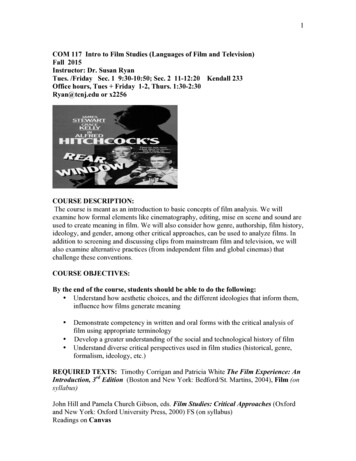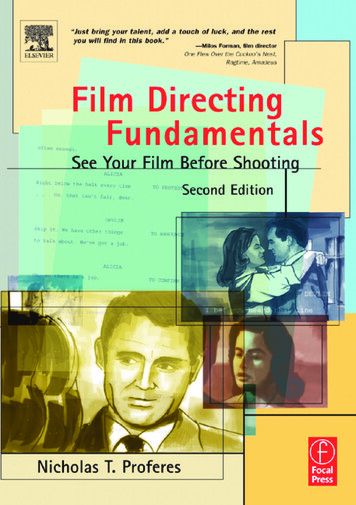
Transcription
FILM DIRECTINGFUNDAMENTALS
Film DirectingFundamentalsSecond EditionSee Your Film Before ShootingNicholas T. ProferesAmsterdam Boston Heidelberg LondonNew York Oxford Paris San DiegoSan Francisco Singapore Sydney TokyoFocal Press is an imprint of Elsevier
Focal Press is an imprint of Elsevier200 Wheeler Road, Burlington, MA 01803, USALinacre House, Jordan Hill, Oxford OX2 8DP, UKCopyright 2005, Elsevier Inc. All rights reserved.No part of this publication may be reproduced, stored in a retrieval system, ortransmitted in any form or by any means, electronic, mechanical, photocopying,recording, or otherwise, without the prior written permission of the publisher.Permissions may be sought directly from Elsevier’s Science & Technology RightsDepartment in Oxford, UK: phone: ( 44) 1865 843830, fax: ( 44) 1865 853333,e-mail: permissions@elsevier.com.uk. You may also complete your request on-line viathe Elsevier homepage (http://elsevier.com), by selecting “Customer Support” and then“Obtaining Permissions.”Recognizing the importance of preserving what has been written, Elsevier prints its bookson acid-free paper whenever possible.Library of Congress Cataloging-in-Publication DataProferes, Nicholas T.Film directing fundamentals : see your film before shooting / Nicholas T. Proferes. —2nd ed.p. cm.Includes bibliographical references and index.ISBN 0-240-80562-31. Motion pictures — Production and direction. I. Title.PN1995.9.P7P758 2004791.4302 33 — dc222004019069British Library Cataloguing-in-Publication DataA catalogue record for this book is available from the British Library.ISBN: 0240805623For information on all Focal Press publicationsvisit our website at www.books.elsevier.com04 05 06 07 08 09 10 9 8 7 6 5 4 3 2 1Printed in the United States of America
To Frank DanielA great teacher,a generous colleague,a delightful friend.
CONTENTSFOREWORDACKNOWLEDGMENTSxixiiiPART ONE LEARNING HOW TO DRAWChapter 1Chapter 2Chapter 3INTRODUCTION TO FILM LANGUAGEAND GRAMMARThe Film WorldFilm LanguageShotsFilm GrammarThe 180-Degree RuleThe 30-Degree RuleScreen DirectionFilm TimeCompressionElaborationFamiliar Images3334558911111212INTRODUCTION TO THE DRAMATIC ELEMENTSEMBEDDED IN THE SCREENPLAYSpinesWhose Film Is It?CharacterCircumstanceDynamic g Beats1414161617171818191919ORGANIZING ACTION IN A DRAMATIC SCENEDramatic BlocksNarrative Beats212121
viiiFILM DIRECTING FUNDAMENTALSThe FulcrumDramatic Elements in Notorious Patio SceneNotorious Patio Scene Annotated222223Chapter 4STAGINGMain FunctionsPatterns of Dramatic MovementChanging the Stage Within a SceneStaging as Part of a Film’s DesignWorking with a Location Floor PlanFloor Plan and Staging for Notorious Patio Scene30303233343434Chapter 5THE CAMERAThe Camera as NarratorThe RevealEntrancesThe Objective CameraThe Subjective CameraWhere Do I Put It?Visual DesignStyleCoverageCamera HeightLensesCompositionWhere to Begin?Working Toward Specificity in VisualizationLooking for OrderDramatic Blocks and the CameraShot Lists and StoryboardsThe Prose apter 6CAMERA IN NOTORIOUS PATIO SCENEFirst Dramatic BlockSecond Dramatic BlockThird Dramatic BlockFourth Dramatic Block and FulcrumFifth Dramatic Block545459616667PART TWO MAKING YOUR FILMChapter 7DETECTIVE WORK ON SCRIPTSReading Your ScreenplayA Piece of Apple Pie ScreenplayWhose Film Is It?CharacterCircumstanceSpines for A Piece of Apple PieDynamic Relationships7777788383838485
ixContentsWantsActionsActing BeatsActivityTone for A Piece of Apple PieBreaking A Piece of Apple Pie into ActionsDesigning a SceneVisualizationIdentifying the Fulcrum and Dramatic BlocksSupplying Narrative Beats to A Piece of Apple PieDirector’s NotebookChapter 88586868686878788888996STAGING AND CAMERA FOR A PIECEOF APPLE PIEStagingCameraConclusions9797100130MARKING SHOOTING SCRIPTS WITHCAMERA SETUPS131Chapter 10WORKING WITH ACTORSCastingFirst Read-ThroughDirecting During RehearsalsDirecting Actors on the Set139140143144147Chapter 11MANAGERIAL RESPONSIBILITIES OFTHE DIRECTORDelegating Authority While Accepting ResponsibilityThe ProducerThe Assistant DirectorA Realistic Shooting ScheduleWorking with the CrewWorking with the Director of ingMusic and SoundLocking Picture, or How Do You Know When It’s Over?An Audience and a Big Screen154154156157157Chapter 9Chapter 12PART THREE LEARNING THE CRAFT THROUGH FILM ANALYSISChapter 13ALFRED HITCHCOCK’S NOTORIOUSOverview of Style and DesignFirst ActSecond ActThird ActSummary161161162165178179
xFILM DIRECTING FUNDAMENTALSChapter 14PETER WEIR’S THE TRUMAN SHOWOverview of Style and DesignFirst ActSecond ActThird ActSummary180180182187199204Chapter 15FEDERICO FELLINI’S 8-1/2A Masterpiece?The Director as AuteurDramatic ConstructionOverview of Style and DesignDetective WorkFirst ActSecond ActThird ActSummary205205205206206208209220235238Chapter 16STYLES AND DRAMATIC STRUCTURESTokyo Story, Yasujiro Ozu (1953, Japan)Some Like It Hot, Billy Wilder (1959, USA)The Battle of Algiers, Gillo Pontecorvo (1965, France)Red, Krzysztof Kieslowski (1994, Poland, France,Switzerland)Sex, Lies, and Videotape, Steven Soderbergh (1989, USA)Shall We Dance?, Masayuki Suo (1996, Japan)The Celebration, Thomas Vinterberg (1998, Denmark)The Insider, Michael Mann (1999, USA)The Thin Red Line, Terrence Malick (1998, USA)240240242244Chapter 17WHAT NEXT?Writing for the DirectorBegin Thinking About Your StoryConcocting Your Feature Screenplay“Writing” Scenes with ActorsShooting Your Film Before You Finish Writing ItThe Final ScriptShooting Without a Screenplay?Questions Directors Should AskAbout Their ScreenplaysBuilding Directorial MusclesDirecting ExercisesMake A Piece of Apple Pie Your 7258258260260261261261262263263269269271272
FOREWORDHow do you teach film directing? Nick Proferes’ book, Film Directing Fundamentals, answers the question perfectly by providing a clear and concise methodologyto the directing student. It is the only book I know of that addresses both the artand craft of directing. It not only offers a step-by-step process to follow but engagesthe reader as if he or she were sitting in Nick’s class. His language is accessible, andhe uses wonderful examples and clear, in-depth analysis that inspires you to thehighest kind of effort.When I first started teaching at Columbia University, I looked through manytexts to find one to recommend to film students who wanted to become directors.Some books were informative but extremely technical and hard to follow; otherswere oversimplified or were anecdotes by a particular director. None offered thestudents a concrete, organic approach. At Columbia, Nick addressed this problemby teaching a lecture course for all beginning students in our graduate film program.His focus is on training directors to engage their audience emotionally by first ofall becoming clear on their story (detective work), then helping the director toorchestrate the progression and dramatic escalation of that story. The organizationof action through dramatic blocks, narrative beats (director’s beats), and a fulcrumaround which a scene moves are categories Nick identifies for the first time.Film Directing Fundamentals also provides a close analysis of three feature filmsto give the reader a chance to look at and understand how to use the dramatic elements as tools in their own work. The book leads us through an almost shot-byshot discussion of dramatic structure and narrator’s voice in Hitchcock’s Notorious,Fellini’s 8-1/2, and Peter Weir’s The Truman Show, and examines style and dramaticstructure in nine other feature films.Although I have been an artist and a director for a number of years, it wasn’tuntil I started teaching that I truly began to understand my own process. To havea book that tracks the process so precisely is invaluable to me as a teacher and asa filmmaker. I consulted this book before, during, and after my last film project,and it is certainly a book I will use again and again.— Bette GordonVice Chair and Directing Supervisor of Columbia University Film DivisionDirector of the feature films Variety and Luminous Motion
ACKNOWLEDGMENTSThis book could not have been written without feedback from the hundreds of students who attended my directing workshops at Columbia University. Their probingquestions and impassioned work forced me to constantly clarify my teaching tobetter serve them, and I thank them one and all. I am also immensely grateful tomy colleagues for their support, especially Bette Gordon and Tom Kalin, and forany of their wisdom I may have purloined without attribution.I owe sincere gratitude to my colleague James Goldstone for his dedicatedreading of the manuscript and for his valuable suggestions, and to Andy Pawelczakand my son Ted Proferes for their astute editorial contributions. I thank the following students: Branislav Bala for his insightful comments on Part I, Jason Grahamfor his short screenplay The Marriage Bed, Sonny Quinn for the The Piece of ApplePie storyboards, Greg Bunch for the diagrams, and Patrick O’Connor for digitizingthe artwork.I am deeply grateful to all of the directors and writers whose films I rely on fortheir masterful demonstration of the directing craft, and to Kostas Matsoukas, atrue lover of film and owner of Video Express in Astoria, New York, who suppliedme with each of the films. I also want to express thanks to my publisher, Marie Lee,at Elsevier, who made this happen, and to my wonderful editor, Terri Jadick.For this second edition, I sincerely thank Elinor Actipis, my new editor, whohas been a godsend; Angela Dooley, Senior Project Manager, and Daril Bentley,Copyeditor, for guiding the manuscript through production; Branislav Bala andPedja Zdravkovic, for the Notorious diagrams and artwork; and Professor WarrenBass for his close reading and invaluable suggestions throughout the entire process.
PARTONELEARNING HOW TO DRAWExcitement, passion, surprise, beauty — these are the things I think about whenmaking a film, and these are the things my students think about. They cannot berealized unless the director’s vision is wedded to a firm grasp of the directing craft.With that end in mind, this book sets out to introduce you to the conceptual aspectsof this craft, and to offer a step-by-step methodology that will take you from thescreenplay to the screen.This second edition has benefited from the many questions I am still asked bystudents concerning the implementation of this methodology, so that I have endeavored here to be as clear as I ask my directing students to be. I have rearranged thematerial from the first edition, and most importantly, have added new chapters andartwork that I believe amplify, clarify, and ultimately, justify this second edition. Ihave devoted a separate chapter to “Organizing Action in a Dramatic Scene,” stressing the three dramatic elements that are unique to my methodology: DramaticBlocks, Narrative Beats, and the Fulcrum. I have also added an in-depth analysis ofa dramatic scene from Alfred Hitchcock’s Notorious, complete with floor plans forstaging and camera, along with storyboards from the film. Another innovation Ihave found to be extremely helpful for student directors is the Prose Storyboard,and in this edition I have included examples.Finally, this second edition includes an Instructor’s Manual, offering instructorsa medley of curricula options including a week-by-week “Introductory DirectingWorkshop” and an “Advanced Directing Workshop,” complete with field-testedexercises designed to facilitate the student’s mastery of the methodology offeredin this book. Qualified instructors can request the manual by emailing textbook@elsevier.com.This methodology is based on the experiences of my own professional careeras a director, cameraman, film editor, producer, and graduate filmmaking teacherfor 20 years at Columbia University, in the School of the Arts’ Film Division. I havetaught more than 80 semester-long directing workshops where students have mademany hundreds of films, and I have supervised more than a hundred thesis films. Itwas as a teacher that I realized the need for an organic, comprehensive text ondirecting. To put off the job of writing such a text, I developed a series of lecturesI delivered at Columbia and at seminars in Europe. Still my students wanted a book.I began with a 30-page handout that has evolved over the years into the presentbook. The emphasis throughout is on the craft of narrative storytelling in the“classical” sense. The goal is to offer a toolbox that is fully equipped with every
2PART ONEessential tool that can then be used to craft any kind of story. To use anothermetaphor, I want to develop all of the student’s directorial muscles.I make an assumption about the audience for this book — that they will want toengage their audience in a cinematic story. Everything contained in this book isaimed at that goal, which I believe is a laudable one. Human beings are in need of narrative and always have been. It has played a significant part in all the diverse culturesof the world, and perhaps even in development of the species itself. Out of concernfor survival, our brains are constructed to make sense of incoming stimuli. Given anythree facts or images, I, we, all of us, including our ancestors from forty thousandyears ago, are on our way to making sense of these facts; in other words, to making astory. A movement in the grass, birds taking flight, an unnatural stillness, and a CroMagnon might begin concocting a scenario of a leopard stalking him.When I first began teaching, students would ask me what books they shouldread about filmmaking, I would tell them Dear Theo, Vincent Van Gogh’s letters tohis brother. I still think anyone aspiring to be a film director should read this book— not for t
Film Directing Fundamentals also provides a close analysis of three feature films to give the reader a chance to look at and understand how to use the dramatic ele-ments as tools in their own work. The book leads us through an almost shot-by-shot discussion of dramatic structure and narrator’s voice in Hitchcock’s Notorious,


